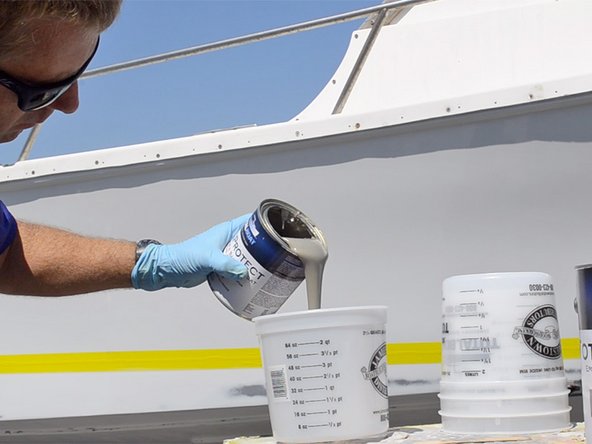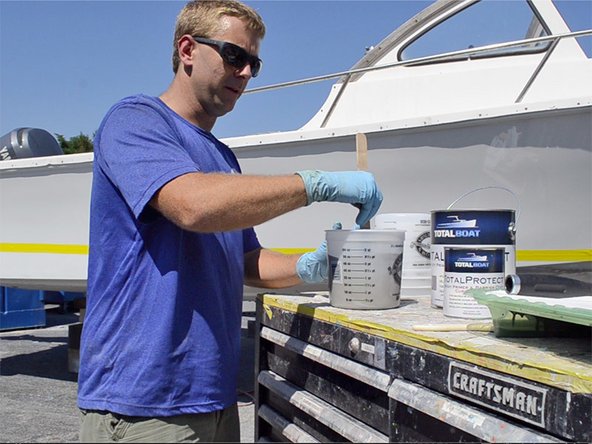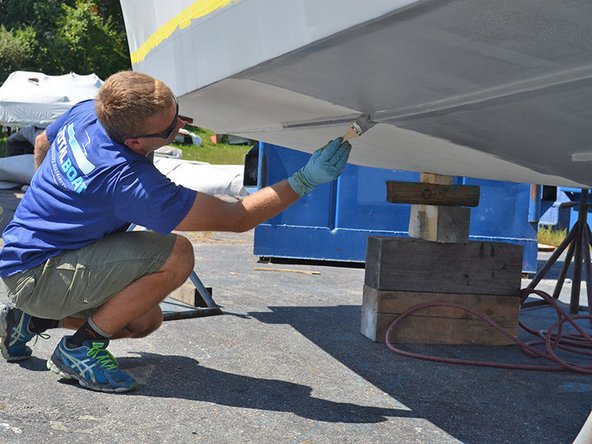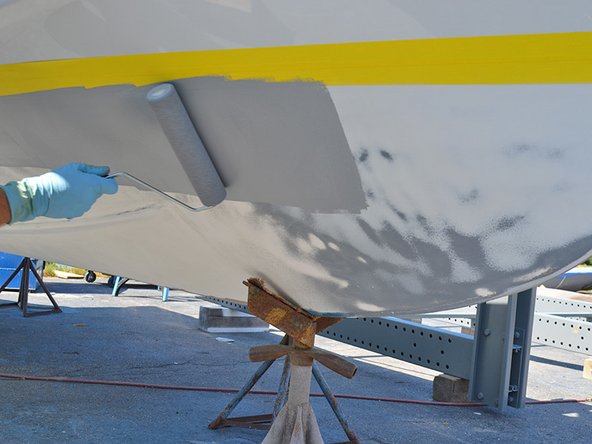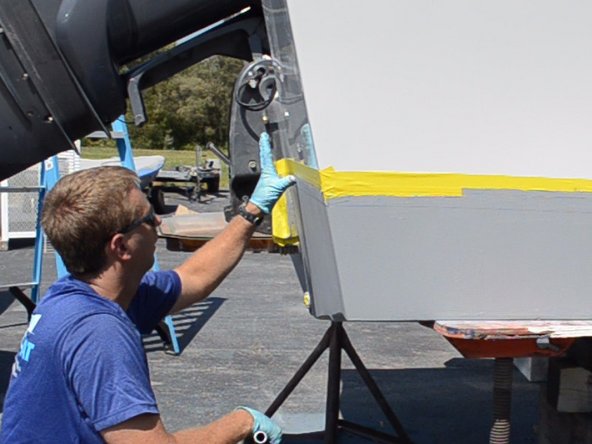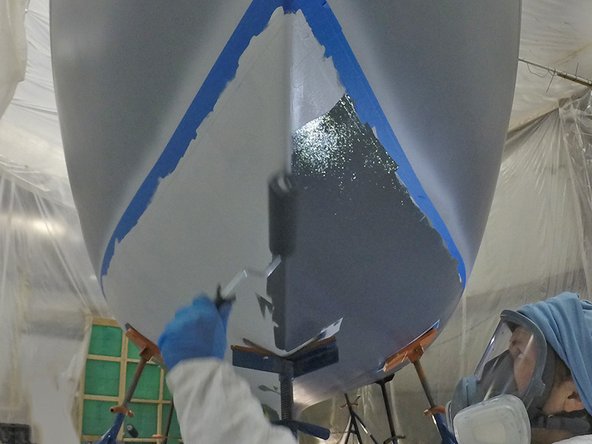Introduction
A barrier coat seals the surface, making it impenetrable to water in order to prevent blistering, which compromises the integrity of your hull. A barrier coat primer is typically applied prior to applying bottom paint. TotalBoat TotalProtect Epoxy Barrier Coat Primer is a high-build, two-component epoxy primer applied at 8-12 mils thickness for barrier coating to protect against water absorption, migration, and gelcoat blistering. TotalProtect can also be used above or below the waterline as a universal epoxy primer for all surfaces, and is easy to apply by brushing, rolling or spraying.
Tools
Video Overview
-
-
Fiberglass or Wood: Wipe the surface with a lint-free rag wetted with TotalBoat Dewaxer & Surface Prep to remove surface contaminants including dust, wax, oil, and grease. Mask the waterline. Sand lightly with 80-grit sandpaper; remove residue by wiping with a lint-free rag dampened with Dewaxer & Surface Prep.
-
Fiberglass Blister Repair: Sand to expose gelcoat blisters; puncture and grind out only the affected laminate at each. Rinse with water and let dry completely. Solvent wipe with denatured alcohol or acetone. Apply TotalBoat TotalFair to each blister and let it cure. Sand with 80-grit. Remove residue and apply TotalProtect, as directed.
-
Aluminum: Sandblast or disc sand the surface down to shiny metal. Brush or vacuum to remove residue. Wipe with a lint-free rag dampened with TotalBoat Dewaxer & Surface Prep. For best adhesion, use TotalBoat Aluminum Boat Etch Wash, as directed, immediately after sanding. Apply TotalProtect within 1 hour of surface prep.
-
Steel: Sandblast to SSPC-SP 6 Commercial blast or grind the surface until it is bare, shiny metal. Remove all residue (sweep, brush, vacuum, compressed air). Wipe clean with a clean, lint-free cotton rag dampened with TotalBoat Dewaxer & Surface Prep, and follow with a clean, dry cotton rag. Apply TotalProtect within 1 hour of metal prep.
-
Lead: Disc sand or abrade the surface to bright metal (3-4 mil anchor profile). Remove all residue. When applying on lead, TotalProtect must be applied immediately after grinding to shiny metal, before the surface turns dull. Immediately apply 1 coat of TotalBoat TotalProtect thinned 20% (yes, 20%) with TotalBoat Epoxy Primer Thinner 200.
-
Iron: Sand, grind, or abrade the surface to bright metal and remove any residue. For any areas that have red rust, use TotalBoat Rust Primer, as directed on the label. To ensure the best bond, apply 1 coat of TotalBoat TotalProtect within 1 hour of completing all surface prep.
-
Previously Painted Surfaces: Always verify that you're not attempting to overcoat a 1-part paint. Wipe clean with Dewaxer & Surface Prep. Sand with 80-grit sandpaper and remove all residue. Wipe clean with lint-free rag dampened with TotalBoat Special Brushing Thinner 100. Apply TotalProtect, as directed.
-
-
-
The base and curing agent components contain solids which settle to the bottom of the can. Shake or stir the curing agent (small can) and base (big can) components thoroughly before dispensing and combining.
-
It’s important to stir or shake each component separately to be sure the solids are mixed in thoroughly for each component BEFORE you combine the components and stir again.
-
-
-
For smaller applications, pour the desired amount of TotalProtect into a clean, dry, disposable mixing pot. Always dispense the proper amount of base and curing agent, which is 3 parts base to 1 part curing agent.
-
If you’re doing a large project and plan to use the whole container, just pour the entire can of curing agent slowly into the can of base. The base container comes partially empty for applications using the whole mixed amount (gallon).
-
TIP: Mix only as much as you can use in 20 minutes. It’s a good idea to mix small amounts until you develop your application technique, especially if you’re doing a spray application.
-
-
-
Use a clean, dry, wooden stir stick to mix both components thoroughly.
-
After mixing, set the can aside and allow TotalProtect to induct for 15 minutes. The induction period is the time it takes for a chemical reaction to occur between the two components, and is very important for the epoxy components to cure properly.
-
After the induction period is over, you can thin, if needed, and apply. TotalProtect should not need thinning, but you can thin up to 10% (by volume) with TotalBoat Epoxy Primer Thinner 200.
-
-
-
You can use a brush, roller, or spray equipment to apply TotalProtect to properly prepared fiberglass, wood, steel, lead, iron, and aluminum.
-
Brush (high-quality natural bristle brush, such as a chip brush); Roller (3/16" - 3/8" nap or foam solvent-safe roller cover); Spray Equipment (pressure pot, conventional, HVLP, or airless/air assisted - see technical data sheet for details on spray equipment setup).
-
Recommended Number of Coats for Barrier Coating: 2-3 coats (minimum), when using a 3/8" roller cover; 3-4 coats, when using a 1/4" roller cover; 4-5 coats, when using a 3/16" roller cover. NOTE: It's more important to ensure 8-12 mils of dry film thickness than a certain number of coats.
-
Substrate-Specific Application Notes: Fiberglass or Wood - Directly before applying TotalProtect, wipe the properly prepared surface with a clean, lint-free cotton rag wetted with TotalBoat Dewaxer & Surface Prep.
-
Steel or Iron - For maximum adhesion, these metals must be shiny and clean. After properly preparing these metal substrates, apply primer within 1 hour.
-
Lead - TotalProtect will not stick to dull, oxidized lead. Apply TotalProtect immediately after preparing the surface by grinding to shiny metal in order to avoid surface oxidation and dulling because lead can oxidize in just minutes to the point of causing poor adhesion.
-
Aluminum - Apply TotalProtect within one hour of surface preparation to avoid oxidation and dulling.
-
-
-
The ‘thumbprint tacky’ test is an easy way to know when to recoat. Press your thumb gently into the TotalProtect film; if you left a thumbprint and your thumb is clean, the surface is ready to apply antifouling paint.
-
Recoat TotalProtect with more TotalProtect within 2 hours to 60 days.
-
If you miss the recoat window, abrade the surface lightly with 80-grit sandpaper, wipe the surface clean with a lint-free cotton rag wetted with TotalBoat Dewaxer & Surface Prep, and let the solvent dry completely before recoating with TotalProtect.
-
TIP: To ensure proper coverage for each coat, you can alternate white and gray colors of TotalProtect so you can easily see any areas you may have missed (see second image).
-
-
-
When using TotalProtect as a barrier coat, it’s critical that you apply antifouling paint over TotalProtect.
-
FOR SOLVENT-BASED ANTIFOULING PAINTS: Do the thumbprint test again to know when to overcoat. Press your thumb gently into the TotalProtect film; if you left a thumbprint and your thumb is clean, the surface is ready to apply antifouling paint.
-
The good news is that if you overcoat with antifouling paint within 3-10 hours (see temperature details in technical data sheet), you don’t need to sand between coats.
-
If you miss the recoat window, wait 24 hours and abrade the surface lightly with 80-grit sandpaper, wipe the surface clean with a lint-free cotton rag wetted with TotalBoat Dewaxer & Surface Prep, and let the solvent dry completely before overcoating with antifouling paint.
-
FOR TEFLON™, VINYL, AND WATER-BASED ANTIFOULING PAINTS: TotalProtect must be fully cured and sanded before application of these antifouling paints.
-
-
-
TotalBoat TotalProtect is a great foundation for topside paints and coatings other than antifouling paints.
-
For these coatings, it's very important to allow the TotalProtect to cure enough to be sanded (24 hours @ 50ºF, 16 hours @ 70ºF, or 12 hours @ 90ºF.
-
Sand the TotalProtect smooth to the required grit for the coating.
-
Remove any sanding residue and apply paint.
-
-
-
The chemicals in barrier coat primers and solvents are hazardous to your health. It's important to wear the proper personal protective equipment (PPE), which will vary based on the job at hand and the products used.
-
Before you begin any project, we recommend the following:
-
Carefully read the safety information on all product labels.
-
Review the information in the SDS (safety data sheets) for each product, including Section 8: Exposure Controls/Personal Protection.
-
Gather the proper PPE items, as stated by the manufacturers. Items can include, but are not limited to, the following:
-
Proper respirators for product application and for sanding cured material.
-
Suitable gloves to protect your hands.
-
Proper eye, face, skin, and clothing protection.
-
-
-
TotalProtect did not cure properly: Improper mix ratio: The mix ratio is 3:1 by volume. Adding extra activator will not make it cure faster; it will lead to an improper cure. Extra base will have similar end results.
-
Improper thinning: Adding more thinner than recommended has adverse effects during the curing process. Always thin TotalProtect to a maximum of 10%, by volume. TotalBoat Epoxy Primer Thinner 200 is the recommended reducer for brushing, rolling, and spraying.
-
TotalProtect did not adhere to TotalProtect. Recoated too soon: Using the ‘thumbprint tacky’ method properly will give quick build in the shortest amount of time. If TotalProtect is recoated too quickly, it can be tougher to roll or to apply properly. Also, solvents may become trapped in the previous layers, leading to other problems.
-
Waited too long to overcoat: If too much time lapses before TotalProtect is reapplied, the previous application will be fully cured and hard. Any amines in the epoxy will settle on the surface, depriving the next coat of a good bond. To fix it, give the previous application a light scuff with 80-grit sandpaper to give a strong mechanical bond.
-
Antifouling paint did not adhere to TotalProtect. Improper prep: Sand back if needed and start over, or remove product with solvents. When overcoating with solvent-based antifouling (not including specialty racing coatings) use the thumbprint tacky method to overcoat.
-
Incompatible items: Sand or use solvents to remove any failing coatings. When overcoating with water-based antifouling, we advise to wait until TotalProtect is fully cured, while solvent-based bottom paints can be applied when the final coat of TotalProtect is 'thumbprint tacky'.
-





